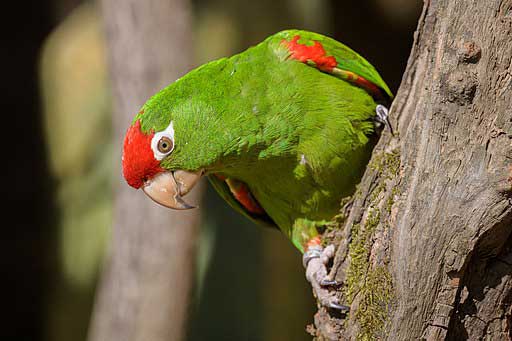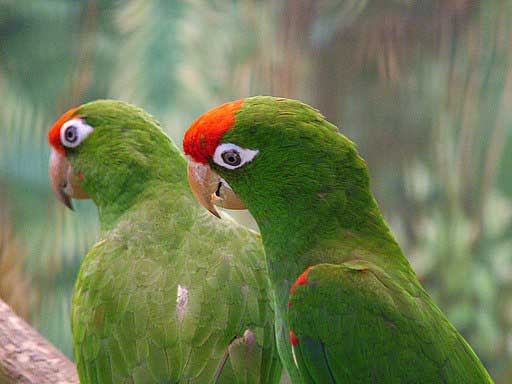
Psittacara

frontatus
Size:
38 cm (15 in.)
Weight:
200-240 g (7-8.4 oz.)
Subspecies including nominate:
two: P.f. frontatus, P.f. minor
Colour Adult:
P.f. frontatus: Both adults red forecrown; red around lores and eyes, eye rings bare and white; red thighs and bend of wing to carpal edge. Beak buff/light pink. Large.
P.f. minor: Both adults as in frontatus but smaller; overall colour darker without bronze/yellow tinge of frontatus; red on thighs paler and more extensive; upper mandible notch rounded.
Colour Juvenile:
Not recorded.
Call:
Calls made in flight are repetitious and high-pitched, discordant notes; higher in pitch than that of Mitred Conure Psittacara mitrata.
More Information:
Content Sources:
BirdLife International
Cornell Lab of Ornithology/Birds of the World
Captive Status:
—
Longevity:
—
Housing:
—
Diet:
—
Enrichment:
—
Nest Box Size:
—
Clutch Size:
Likely 3-4 eggs, as in P. wagleri.
Fledging Age:
—
Hatch Weight:
—
Peak Weight:
—
Weaning Weight:
—
World Population:
Unknown, decreasing.
IUCN Red List Status:
Near Threatened
CITES Listing:
Appendix II
As conspecific with P. wagleri.
Threat Summary:
Not globally threatened. The species has been heavily trafficked; wild-caught individuals were recorded in international trade before it was listed on CITES Appendix II. International trade declined rapidly after the 1980s in Peru, but rose again in the early 1990s. Habitat loss is presumed to have some effect, as well as persecution as a crop pest. Is very rare in Ecuador.
Range:
P.f. frontatus: Pacific slope of Andes in S Ecuador and W Peru, south to Tacna.
P.f. minor: C Andes of Peru from Rio Maranon valley, Amazonas and possibly Zumba district in nearby S Ecuador, south to Ayacucho and Apurimac.
Habitat:
Inhabits semi-arid cloud forest and similar areas to P. wagleri but is generally relies more on semi-humid or humid montane scrub, including cactus formations.
Wild Diet:
Unknown, but noted to visit orchards and corn fields.
Ecology and Behaviour:
Seen in social groups of up to 20; occasionally 300 or more. Feeds in the canopy and roosts at dusk in communal roosting areas in cliffs, which are also required for nesting.
Clutch and Egg Size:
Likely 3-4 eggs, as in P. wagleri.
Breeding Season:
Timing unknown, but apparently nests colonially in cliff faces.
Related Links:
—



![© Petr Hamerník [CC BY-SA 4.0] via Wikimedia Commons A Cordilleran Conure perches on a tree](https://parrots.org/wp-content/uploads/2023/01/wpt-cordilleran-conure1_2266-100x100.jpg)
![© Michael Gwyther-Jones [CC BY 2.0] via Wikimedia Commons A closeup of two Cordilleran Conures](https://parrots.org/wp-content/uploads/2023/01/wpt-cordilleran-conure3_2266-100x100.jpg)
![© Selimalabi [CC BY-SA 3.0] via Wikimedia Commons A closeup of Cordilleran Conures](https://parrots.org/wp-content/uploads/2023/01/wpt-cordilleran-conure2_2266-100x100.jpg)